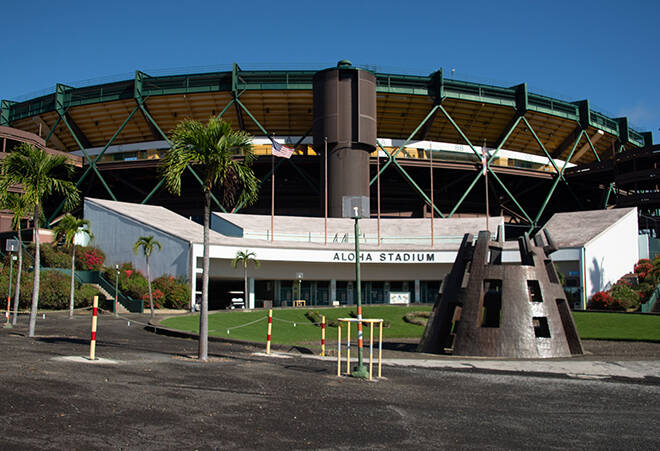Gov. David Ige has halted requests for proposals to build a new Aloha Stadium and will announce in three weeks different plans for its construction, a state official said Tuesday.
Mike McCartney, director of the Department of Business, Economic Development and Tourism, said the $350 million allotted for the project by the state Legislature and approved by Ige will still be used to build a new stadium in Halawa, the same area where the original Aloha Stadium, which opened in 1975 and was shut down two years ago, still stands.
McCartney’s department now oversees stadium issues for the state.
When asked whether the New Aloha Stadium Entertainment District plan that included a public-private partnership is still in play, McCartney would only say, “They gave us the money to build a new stadium with, and that’s the priority.”
McCartney also did not give a timeline for the new stadium’s construction.
“The governor will have a lot to say down the road when we clarify things,” McCartney said. “We’re doing our due diligence. What I’m supposed to tell you is in a few weeks we’ll have more to say, and we want to make sure the project is moving.”
The most recent estimate, announced at the August meeting of the Stadium Authority, was that the stadium would be ready in time for the University of Hawaii football team’s 2027 season.
A recent shift put the stadium under control of DBEDT instead of the state Department of Accounting and General Services.
State Comptroller Curt Otaguro was told by Ige’s chief of staff, Linda Chu Takayama, in an email late last week to stop work on requests for proposals for both the stadium and privately funded real estate portions of the New Aloha Stadium Entertainment District.
Takayama’s email read, in part, “Both RFPs that you have been working on in DAGS should not be going forward, as we will be moving in a different direction under DBEDT. Please consider tying up any loose ends from your side.”
The email also indicated that the environmental impact statement to build in the Halawa area will be approved by Ige, which McCartney confirmed Tuesday.
“Our current strategy is to accept the original EIS on stadium very soon, acknowledging that the responsibility and funding for the stadium now rests with the Stadium Authority and DBEDT,” Takayama’s email said.
There was no direct mention of the public-private partnership funding model in the email.
In a phone interview Tuesday, Otaguro said he was surprised by the email but added, “We get our marching orders from the governor, so we continue on and follow the law.
“The model we thought made sense was (public-private partnership),” Otaguro said. “It’s one of the few that could make a profit long-term.”
Chris Kinimaka, public works administrator for DAGS, also was surprised by the order to stop work on requests for stadium proposals.
“It was a lightning bolt out of the blue,” Kinimaka said. “Curt has been going back and forth with the governor, telling him if he ever wants us to stop, just tell us. He never indicated for us to stop.”
Ige’s second and final term as governor ends in December.
Cindy McMillan, Ige’s communications director, told the Honolulu Star-Advertiser on Tuesday, “The administration is currently conducting its due diligence following the enactment of laws this year relating to Aloha Stadium. We are committed to developing a feasible course of action for the university’s sports programs, UH fans and the state of Hawaii.”
The recently enacted laws transferred the administrative attachment of the Stadium Authority from DAGS to DBEDT and appropriated general obligation bond funds to DBEDT for a new stadium in Halawa.
But where some see due diligence, others see unnecessary delays.
“The public-private development model and the (New Aloha Stadium Entertainment District) development has the potential to restore the public’s faith in state government and demonstrate that we can do big things,” Stadium Authority board member Michael Yadao said. “But, unfortunately, this delay only hurts the state and the university by eroding public confidence and significantly delaying the procurement.”
McCartney said the project won’t be starting over from scratch.
“A lot of good work was done, and it’s not all gone,” he said. “We all just have to come together and focus and get it done. Keeping it simple is important.”
The UH football team has played its home games at the on-campus Clarence T.C. Ching Complex in Manoa since last season.
UH built what was a practice field into a 9,000-seat facility for the 2021 season. The school in August announced plans to expand capacity to 17,000 in time for the start of the 2023 football season, as part of a $30 million athletic department facilities project.
“We don’t know what this new direction is,” Aloha Stadium manager Ryan Andrews said. “But we are all very interested in finding out.”




